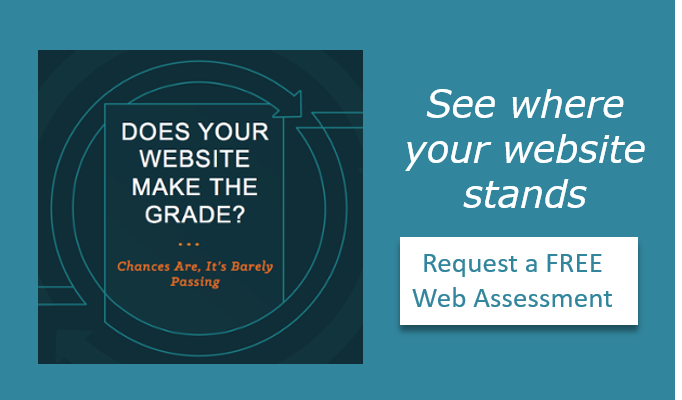
Getting leads today isn’t difficult; however, getting targeted and qualified leads is a different story. That’s because no lead is created equal; every company, and each team within those companies, defines a qualified lead differently. Since there are no boilerplate answers when it comes to B2B lead generation, companies have to get creative and be specific with their goals.
If a marketing campaign isn’t generating sales, executives may ask for ways to get better leads. Qualified inbound lead generation doesn’t happen on its own. In fact, you may be missing a minor, yet critical, step in your visitor conversion and lead generation process. Before you get started with your next sales and marketing campaign, here are 10 things to consider to build better conversion strategies into your website:
1. Refresh Your Content Frequently
This applies to content on both your website and in your social media campaigns: you need fresh content. The reality is, search is changing. People are using keywords less and less and search engines have implemented new algorithms to match the more conversational style of the way people search. Take a deeper dive into your core expertise with a Pillar Content Strategy that is supported by the sub-topics covered in your blog. This approach to content on your website and social media accounts will improve your chances to rank as the search engines get smarter and look to evaluate the intent across the whole of your digital ecosystem. Also avoid sales pitches. Instead, provide valuable information to consumers.
View your website as a resource to answer visitors questions and as an interactive tool for your sales team to utilize in their follow-up. Simply updating your website with fresh content demonstrates to a consumer and sales team you are actively providing beneficial information and resources. The best inbound lead generation sometimes comes from having new and relevant content consumers can rely on any time they need it.
2. Your Target Market Needs to Be Clearly Defined - Personalization is Key
Inbound lead generation is useless if you don’t have a targeted consumer. You need to know what your customers want versus what they need and how they currently get their information. These are the starting points to developing your sales and marketing alignment, since you already know a little bit about your target consumer. Once you understand your target market, you can segment out different customer segments to distinguish the active, in-market buyers versus people who are just looking for information. Tailoring your marketing efforts to the different customer segments will help you use your resources and efforts more effectively and efficiently.
Creating a campaign for multiple stages of the buying process will help you turn unqualified leads into qualified ones if you find them at the right time. You won’t have much success selling a person something if they aren’t ready to buy or have already made a purchase. However, that particular customer may become a purchaser in the future if you provide them with the information they need, even though they are just at the research phase of the buying process.
3. Your Life Will Be So Much Easier with a Closed Loop Sales and Marketing System
Businesses today gain leads through many platforms. Social media campaigns may work for some companies, while email marketing may work more effectively for others. Track your results so you can identify the source of your best leads and focus on those platforms to achieve sales and marketing alignment. HubSpot’s platform is great for this, allowing you to see where a visitor comes from and create a process to track them all the way from their first visit and engagement with marketing channels to sales outreach, to when they become a customer.
4. Experiment and Measure Daily for Your Best Results
You may have an idea of what platforms work best for your B2B lead generation. But you don’t know what you’re missing unless you try other media formats. When you’re first generating leads, trial and error can work. You don’t want to blast your information out among every different media platform at once, but it doesn’t hurt to start with a couple and incorporate others along the way. Not only will using different media formats increase your viewership and create stronger brand awareness, but you’ll also learn more about the success of the messages you’re conveying. As you re-generate content for different platforms, and can adjust as you see fit.
5. Keep Your Website Simple
If you have a complicated website to navigate, customers are more likely to leave before they take action or convert. Complicated design, new and creative functionality and image overload can slow down your website. Website visitors tend to care more about the speed of your website than its creativity. Also, the time it takes to load a page has become more important concerning search engine rankings. Use Google’s Test My Site Tool (https://testmysite.thinkwithgoogle.com) and make sure your website load time is no more than 3 seconds.
6. Simplify Your Forms
You won’t succeed with inbound lead generation if you don’t have forms that are prominent and easily accessible. Request as little personal information as possible in your first level forms to build trust, then ask for slightly more detailed information in the next step of your nurturing campaign. Remember customer details are a valuable currency and visitors will be considering if the offer you are providing warrants the cost. Take it even a step further and tell your customer exactly what you will be doing with their information such as not selling it or using it for any other purposes. Whether it’s contacting them about a specific product, reaching out to them for questions they may have or just providing them general information, creating simple and clear forms will help drive sales and marketing alignment. Also, lean away from requiring a form submission for access to your content. Instead, treat content pages like landing pages, with a built-in form within the content or at the bottom of the page.
7. Don't Overlook Your Call-To-Action
Make your call-to-action big and bold. There is no guaranteed way to get a potential consumer to click on your call-to-action button, but you can make it as clear as possible. It’s a good idea to use short, easy to understand calls to action that invite the reader to take decisive action. Get the point across in as few words as possible while still helping your visitor understand the benefit they’ll get from acting. Words that entice someone to take immediate action, such as tacking on “Download” or “Get” or “Watch” to the end of your CTA are also useful. And test! Use data to test how effective different calls to action are so you can use the one with the best conversion rate.
8. Use Photos and Videos to Improve Engagement
Consumers can relate to photos and videos more than text. However, all three types of media go hand-in-hand. People will look at photos first when they land on a website. If the photos are intriguing and attention-grabbing (as described in this Business Insider article on the topic), they will likely read the text to learn more about the product or service. If a video is available, according to Diode Digital, 60% of customers will watch the video before they read any text. Having photos and videos add credibility to the content on your website and your brand in general. Just be careful not to overdo it. You don’t want your website to look cluttered or slow down as a result.
9. Always Consider The End Goal
Before starting your B2B lead generation campaign, understand what a lead means to you. Knowing what your end goal is for gathering leads will help you create the most specific and targeted strategies for lead generation. Go even further and be clear on what you consider a lead to be. If a lead is just someone who fills out a form, then consider that in your metrics. If you consider a lead to be someone who signs up for a weekly or monthly newsletter and requests specific information, be sure you can measure those leads as well. Having a clear end goal that is shared by both your sales and marketing teams will help shape a framework for alignment from start to finish.
10. Leverage Your Confirmation or Thank You Page
Getting a new customer is great, but they also may be your best advocate for more leads. Use your confirmation page to offer different promotions or ask them to sign up for your newsletter. As with virtually any business, the power of referrals is unmatched. When a customer makes a purchase, offer them a discount or some type of referral bonus for their next purchase. The confirmation page is something you need anyway, so leverage it as much as possible. HubSpot, for example, has some great ideas for how you can use a Thank You page to your advantage. It’s one of the most overlooked parts of inbound lead generation, but it’s also one of the most valuable since you already have an established customer.
Cogo & Co. specializes in helping companies maximize sales and marketing alignment, enabling teams to see returns on investment more quickly. Without this alignment, your business may seem like it’s moving forward, but in reality it’s just spinning its wheels. Every business defines lead generation differently. Mainly, each company should have clearly defined lead generation goals and a plan to work toward them. For more information on effective inbound lead generation and how we can help you develop and execute a plan, be sure to contact us at any time.


